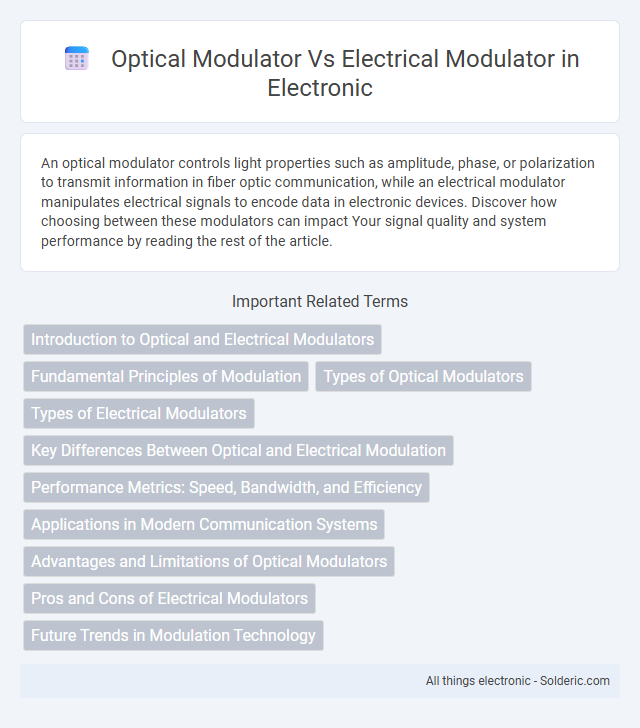An optical modulator controls light properties such as amplitude, phase, or polarization to transmit information in fiber optic communication, while an electrical modulator manipulates electrical signals to encode data in electronic devices. Discover how choosing between these modulators can impact Your signal quality and system performance by reading the rest of the article.
Comparison Table
| Feature | Optical Modulator | Electrical Modulator |
|---|---|---|
| Function | Modulates light signals by varying light intensity, phase, or polarization | Modulates electrical signals by varying amplitude, frequency, or phase |
| Common Types | Electro-optic, Acousto-optic, Liquid crystal modulators | Amplitude Modulator (AM), Frequency Modulator (FM), Phase Modulator (PM) |
| Operating Frequency | Typically optical frequencies (~THz) | Radio to microwave frequencies (kHz to GHz) |
| Applications | Fiber-optic communication, Laser systems, Optical signal processing | Radio broadcasting, Telecommunications, Signal processing circuits |
| Signal Type | Light (photonic signals) | Electrical (analog or digital) |
| Speed | Very high speed, suitable for high bandwidth optical networks | Moderate speed, limited by electronic components |
| Integration | Often integrated with photonic circuits and fiber optics | Integrated in electronic circuits and chips |
| Advantages | High bandwidth, low loss, immunity to electromagnetic interference | Cost-effective, easy to design and implement |
| Disadvantages | Complex manufacturing, higher cost | Limited bandwidth, susceptible to noise |
Introduction to Optical and Electrical Modulators
Optical modulators control light signals by varying parameters such as intensity, phase, or polarization, crucial for fiber optic communication and high-speed data transmission. Electrical modulators manipulate electrical signals by altering voltage or current to encode information, widely used in radio frequency and microwave applications. Comparing optical and electrical modulators highlights differences in signal domain, speed, bandwidth, and integration with photonic or electronic systems.
Fundamental Principles of Modulation
Optical modulators manipulate light waves using changes in amplitude, phase, or frequency based on the electro-optic, acousto-optic, or thermo-optic effects, enabling high-speed data transmission in fiber optic communications. Electrical modulators alter electrical signals by varying parameters like amplitude, frequency, or phase through circuit components such as transistors or diodes to encode information in radio frequency or digital communication systems. The fundamental principle in optical modulation relies on direct interaction with photons, whereas electrical modulation depends on electron flow and voltage variations within semiconductor materials.
Types of Optical Modulators
Optical modulators come in various types, including electro-optic, acousto-optic, and liquid crystal modulators, each leveraging distinct physical principles to control light properties such as phase, amplitude, or polarization. Electro-optic modulators, widely used in high-speed telecommunications, utilize electric fields to alter the refractive index of materials like lithium niobate, enabling rapid signal modulation. Understanding the differences between optical modulator types can help optimize Your system's performance by selecting the appropriate technology for specific wavelength, speed, and integration requirements.
Types of Electrical Modulators
Electrical modulators include amplitude modulators (AM), frequency modulators (FM), and phase modulators (PM), each varying the electrical signal to encode information. These modulators manipulate voltage or current to achieve signal changes, making them essential in radio transmission, communication systems, and signal processing. Your choice between electrical and optical modulators depends on the application's bandwidth, speed, and noise resistance requirements.
Key Differences Between Optical and Electrical Modulation
Optical modulators manipulate light waves by varying properties such as amplitude, phase, or polarization, enabling high-speed data transmission in fiber-optic communications, whereas electrical modulators primarily alter electrical signals like voltage or current in electronic circuits. Optical modulators offer superior bandwidth and lower signal loss over long distances compared to electrical modulators, which are limited by electronic component speed and signal attenuation. The key differences include modulation medium (light vs. electrical signals), operational speed, bandwidth capacity, and application environments in telecommunications and integrated photonics.
Performance Metrics: Speed, Bandwidth, and Efficiency
Optical modulators offer significantly higher speed and bandwidth compared to electrical modulators due to their ability to manipulate light directly, enabling data transmission at terahertz frequencies. Electrical modulators are typically limited by electron mobility and circuit parasitics, resulting in lower efficiency and slower performance metrics. Your choice between these modulators depends on whether ultra-high-speed data transfer and wide bandwidth are critical for your application.
Applications in Modern Communication Systems
Optical modulators are essential in high-speed fiber optic communication, enabling efficient data transmission over long distances with minimal signal loss. Electrical modulators are widely used in traditional RF and microwave communication systems, offering precise signal control for wireless networks and electronic devices. Your choice between optical and electrical modulators depends on the specific application requirements, such as bandwidth, distance, and integration with existing infrastructure.
Advantages and Limitations of Optical Modulators
Optical modulators offer high-speed data transmission and immunity to electromagnetic interference, making them ideal for fiber optic communication networks. Their main limitations include complexity in integration and sensitivity to environmental factors such as temperature fluctuations, which can affect performance. You benefit from optical modulators in applications demanding low signal loss and high bandwidth but must consider cost and stabilization challenges.
Pros and Cons of Electrical Modulators
Electrical modulators offer high-speed modulation capabilities and compatibility with existing electronic circuits, making them ideal for integrated communication systems. However, they often suffer from limited bandwidth and higher signal attenuation compared to optical modulators. The sensitivity to electromagnetic interference and increased power consumption also pose challenges in high-frequency applications.
Future Trends in Modulation Technology
Future trends in modulation technology emphasize the growing integration of optical modulators due to their higher bandwidth and lower latency compared to traditional electrical modulators. Optical modulators leverage advanced materials like lithium niobate and silicon photonics to enable faster data transmission in telecommunications and data centers. Your choice between optical and electrical modulation will increasingly depend on the demands for speed, energy efficiency, and integration at the chip level in emerging applications such as 5G, AI, and quantum computing.
Optical modulator vs electrical modulator Infographic

 solderic.com
solderic.com